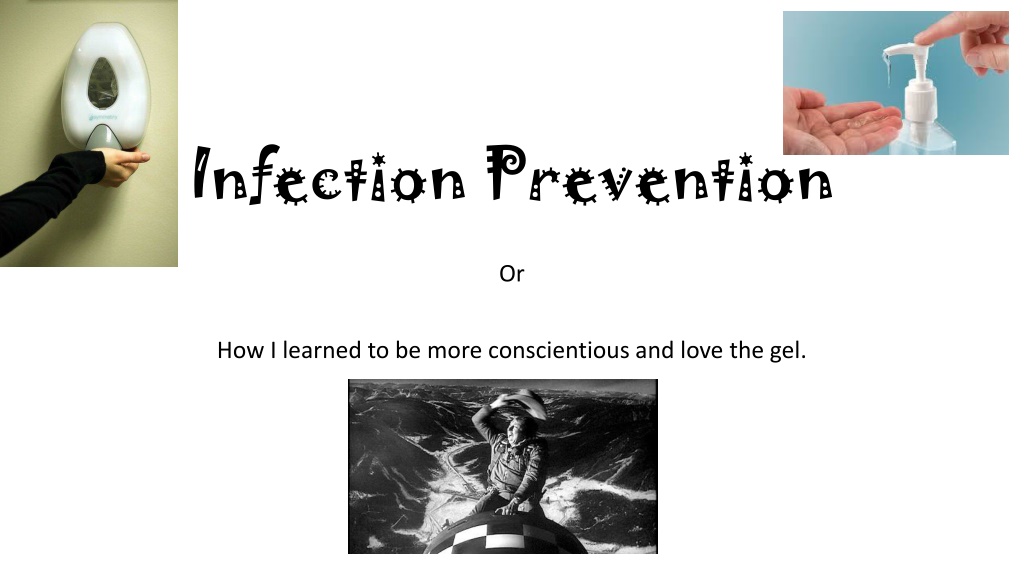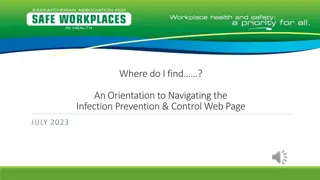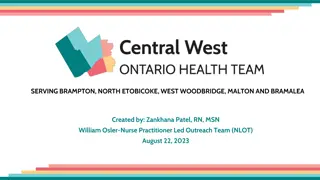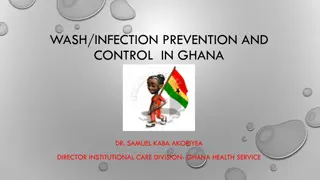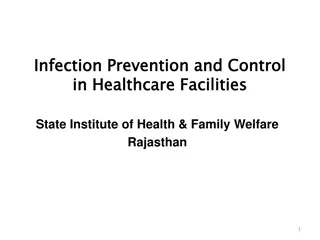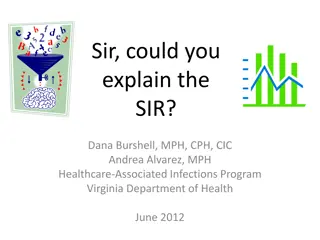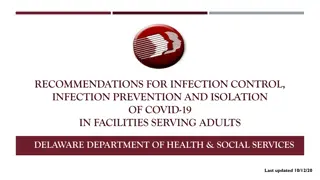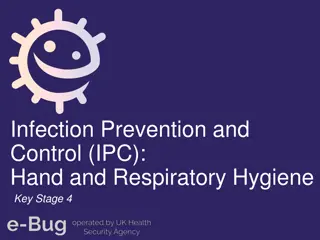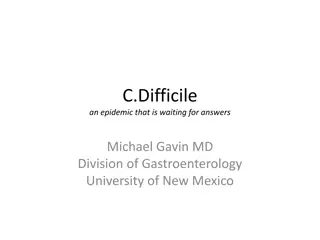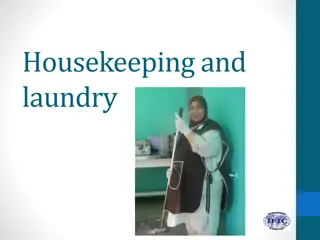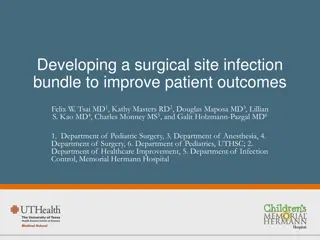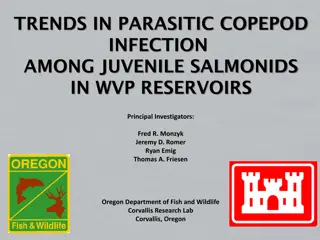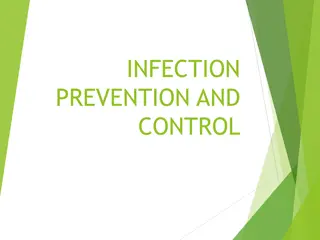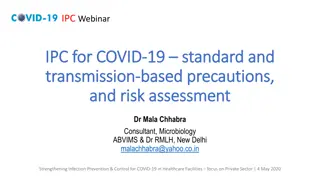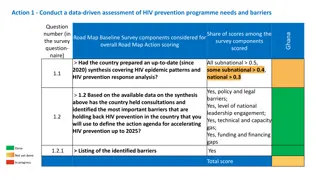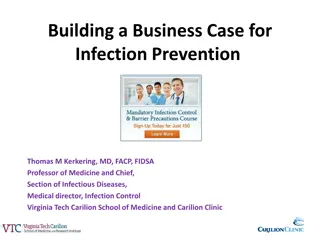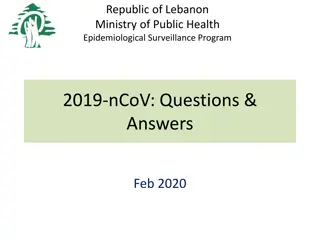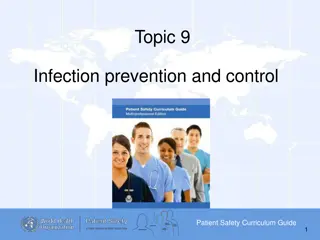Comprehensive Guide to Infection Prevention and Control Practices
Explore the essential practices for infection prevention, including monitoring hand hygiene compliance, educating staff and visitors, understanding how infectious diseases spread, utilizing personal protective equipment, and implementing isolation precautions for various patient conditions. Discover the tools and resources provided by healthcare facilities to ensure a safe environment and minimize the risk of infections.
Download Presentation

Please find below an Image/Link to download the presentation.
The content on the website is provided AS IS for your information and personal use only. It may not be sold, licensed, or shared on other websites without obtaining consent from the author. Download presentation by click this link. If you encounter any issues during the download, it is possible that the publisher has removed the file from their server.
E N D
Presentation Transcript
Infection Prevention Or How I learned to be more conscientious and love the gel.
What do we do? Monitor Hand Hygiene compliance Monitor equipment cleaning Provide education to staff and visitors: Orientation, in service, newsletter, display case, blog, social media Provide education to outpatients/community Provide a resource for staff Research ID Surveillance: CLABSI, CAUTI, SSI Work with engineering on ICRA s, temperature/humidity monitoring, airflow Collect and report data to the local health departments, TxDHS and Nat l Safety Health Network
How Are Infectious Diseases Spread? Understanding how infectious diseases are spread is important for minimizing the risk of infection and preventing disease transmission. Three ways in which infectious diseases can be transmitted: Direct transmission Indirect transmission Airborne transmission
What tools does MCHS provide to keep you safe? Engineering Controls: Sharps Containers, Negative pressure rooms, Air flow Personal Protective Equipment Hand wash stations Proper cleaning products Educational Opportunities Influenza and Hep B vaccinations free to all employees.
Personal Protective Equipment or PPE Consists of gloves, gowns, masks, eye protection, shoe protection Use is based on type of precaution: Standard (Universal) precautions the belief that every patient, every situation is potentially hazardous. Hand Hygeine Gloves Transmission based precautions choosing the correct PPE according to the mode in which a disease is spread. Hand Hygiene Gloves Proper PPE for transmission Isolation precaution signs instruct your behavior for isolation rooms Placed on door of isolation patient rooms Isolation carts with PPE will be outside room
Examples of contact isolation appropriate patients: MDRO s such as MRSA and VRE Draining wounds Scabies, Lice, Bed bugs
Examples of Droplet isolation appropriate patients: Seasonal Flu Bacterial Meningitis Strep Throat Pertussis/RSV
Examples of Airborne/Respiratory precaution appropriate patients: Tuberculosis (TB) Shingles/Chicken Pox (dessiminated) Measles Avian Flu
Examples of Special Enteric precaution appropriate patients: Clostridium dificile (C.diff) Norovirus Acute Diarrhea
Hand Washing Components of proper hand washing include: - Soap - Clean water - Hand gel/sanitizer - Friction (F-R-O-G: Friction rubs out germs)
Hand Hygiene Your hands are NASTY! Think of everything you touch in a single day! Some things we can see: Blood, feces, other matter. Some things we can t see: bacteria, viruses, spores. Hand washing is your first line of defense for your safety AND your patient s. Remember: If it s wet, slimy and not yours, don t touch it.
What things should you do to keep yourself, your patients and your co-workers safe? Wash Your Hands Clean your equipment Ask colleagues to wash their hands Educate patients/patient families about hand washing and isolation precautions Get vaccinated annually! Wash Your Hands
When to Wash Hands Before and after glove use After blowing the nose, sneezing, or coughing After going to the bathroom After contact with blood or body fluids, such as saliva, nasal secretions, urine, feces, or vomit After handling garbage or waste When hands appear soiled Before preparing medicines or handling contact lenses Before preparing, serving, or handling food Before eating lunch or snacks Frequently when sick or after contact with others who are sick Before and after touching a cut or wound Before and after touching eyes, nose, or mouth After handling animals, animal waste, or their belongings, such as toys or a leash After changing a diaper
Ways to prevent spreading infection Encourage personnel to wash hands frequently using soap and water for 15-20 seconds. Substitute alcohol-based hand sanitizer when clean water and soap are unavailable. Promote appropriate respiratory etiquette: Cover coughs and sneezes with tissue. Throw away tissues immediately and WASH YOUR HANDS. If a tissue is not available, sneeze or cough into the elbow or upper sleeve. Remain at home when ill and encourage others to do the same. Avoid close contact (less than 3 feet of space) with those who are sick Maintain and promote good personal hygiene; bathe and wash hands regularly Discourage touching the eyes, nose, and mouth. Maintain a clean working environment. Ensure commonly used areas such as door handles, eating surfaces, and desks are clean and disinfected.
Keep open or draining wounds clean and covered with a bandage. Avoid contact with other people s wounds or bandages. Discourage sharing eating utensils, glassware, or personal items such as combs, razors, towels, clothing or other items that come into contact with bare skin. Clean shared equipment before and after each use. Avoid skin-to-skin contact with anyone who has an open wound or skin infection. Encourage a healthy lifestyle that includes a nutritious diet and adequate sleep.
